Rank Species | ||
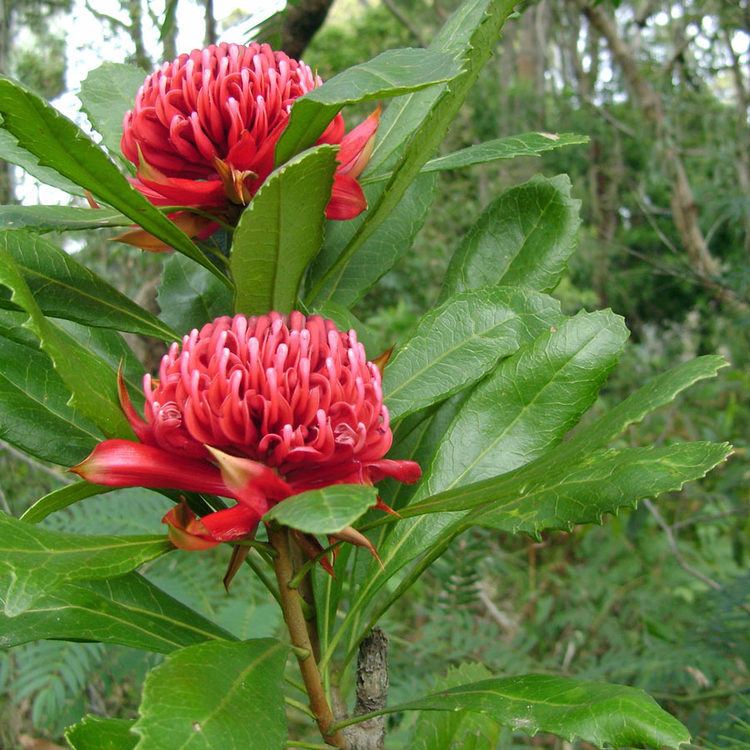 | ||
Similar Waratah, Proteas, Telopea oreades, Telopea mongaensis, Swainsona formosa | ||
Telopea speciosissima, commonly known as the New South Wales waratah or simply waratah, is a large shrub in the plant family Proteaceae. It is endemic to New South Wales in Australia and is the floral emblem of that state. No subspecies are recognised, but the closely related Telopea aspera was only recently classified as a separate species.
Contents

T. speciosissima is a shrub to 3 or 4 m (9.8 or 13.1 ft) high and 2 m (6.6 ft) wide, with dark green leaves. Its several stems arise from a pronounced woody base known as a lignotuber. The species is well renowned for its striking large red springtime inflorescences (flowerheads), each including hundreds of individual flowers. These are visited by the eastern pygmy possum (Cercartetus nanus), birds such as honeyeaters (Meliphagidae), and various insects.
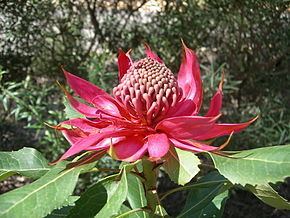
The floral emblem for its home state of New South Wales, Telopea speciosissima has featured prominently in art, architecture, and advertising, particularly since Australian federation. Commercially grown in several countries as a cut flower, it is also cultivated in home gardens, requiring good drainage yet adequate moisture, but is vulnerable to various fungal diseases and pests. A number of cultivars with various shades of red, pink and even white flowers are available. Horticulturists have also developed hybrids with T. oreades and T. mongaensis which are more tolerant of cold, shade, and heavier soils.
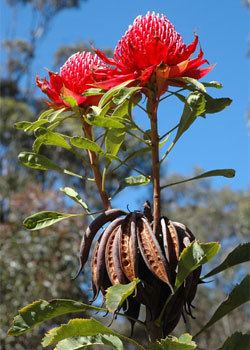
Description
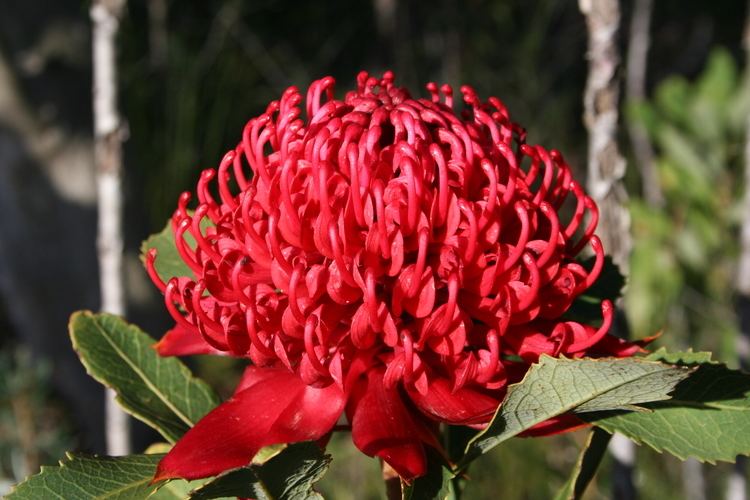
Telopea speciosissima, the New South Wales waratah, is a large, erect shrub up to 3 or 4 metres (9.8 or 13.1 ft) in height with one or more stems. Arising vertically or near vertically from a large woody base, or lignotuber, the stems are little branched. In late spring, there is a spurt of new growth after flowering, with new shoots often arising from old flowerheads. The dark green leaves are alternate and usually coarsely-toothed, ranging from 13 to 25 cm (5 to 10 in) in length. Enveloped in leafy bracts, the flowerheads develop over the winter and begin to swell in early spring, before opening to reveal the striking inflorescences. The exact timing varies across New South Wales, but flowering can begin as early as August in the northern parts of its range, and finish in November in the southern, more elevated areas. Spot flowering may also occur around March in autumn. Containing up to 250 individual flowers, the domed flowerheads are crimson in colour and measure 7–10 cm (3–4 in) in diameter. They are cupped in a whorl of leafy bracts which are 5 to 7 cm (2 to 3 in) long and also red. Variations are not uncommon; some flowerheads may be more globular or cone-shaped than dome-shaped, and the bracts may be whitish or dark red. The tips of the stigmas of some inflorescences may be whitish, contrasting with the red colour of the rest of the flowerhead.
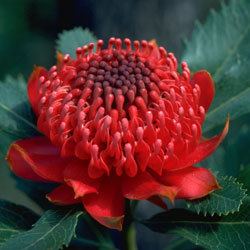
An individual flowerhead reaches full size about two weeks after first emerging from the bracts, and lasts another two weeks before the flowers fade and fall. In the first phase, the individual small flowers, known as florets, remain unopened—and the flowerhead retains a compact shape—before they mature and split open, revealing the stigma, style, and anther. The anther is sessile, lacking a filament, and lies next to the stigma at the end of the style. The outermost florets open first, with anthesis progressing towards the centre of the flowerhead, which becomes darker and more open in appearance, and begins attracting birds and insects. The ovary lies at the base of the style and atop a stalk known as the gynophore, and it is from here that the seed pods then develop. Meanwhile, a crescent-shaped nectary lies at the base of the gynophore.
The seed pods grow to 8–15 cm (3–6 in) long. As the pods mature, they range from green, to yellow and finally turn russet red-brown. The pods become leathery before splitting open during early winter,. The pods contain winged seeds inside. In the wild, only two or three seed pods develop per flowerhead, but there may be anywhere from 5 to 50 in cultivated plants.
Taxonomy
Telopea speciosissima, the New South Wales Waratah, was first described by botanist James Edward Smith in his 1793 book A Specimen of the Botany of New Holland, from "very fine dried specimens sent by Mr. White". He gave the species its original binomial name of Embothrium speciosissimum. The specific epithet is derived from the superlative of the Latin word speciosus "beautiful" or "handsome", hence "very-" or "most beautiful". Embothrium had been a wastebasket taxon at the time, and Robert Brown suggested the genus Telopea for it in 1809, which was published in 1810. Richard Salisbury had published the name Hylogyne speciosa in 1809, but Brown's name was nomenclaturally conserved.
Telopea speciosissima is one of five species from southeastern Australia which make up the genus Telopea. Its closest relative is the very similar Gibraltar Range waratah (T. aspera) from northern New South Wales, which was only recognised as a separate species in 1995, having previously been considered an unusual northern population of T. speciosissima.
The genus is classified in the subtribe Embothriinae of the Proteaceae, along with the tree waratahs (Alloxylon) from eastern Australia and New Caledonia, and Oreocallis and the Chilean firetree (Embothrium coccineum) from South America. Almost all these species have red terminal flowers, and hence the subtribe's origin and floral appearance must predate the splitting of Gondwana into Australia, Antarctica, and South America over 60 million years ago.
Although no subspecies are recognised within Telopea speciosissima itself, geographical variations within its range have been noted. Forms toward the northern limits of its range have more prominently lobed leaves. A population from Waterfall has darker red, wider inflorescences, and a population at West Head in Ku-ring-gai Chase National Park has paler inflorescences. Leaf shape varies widely.
The common name waratah was first applied to this species before being generalised to other members of the genus Telopea and, to a lesser extent, Alloxylon. Waratah is derived from the Eora Aboriginal people, the original inhabitants of the Sydney area. The Dharawal people of the Illawarra region knew it as mooloone, and mewah is another aboriginal name. A former common name from around 1900 is "native tulip", possibly derived from Telopea.
Distribution and habitat
The species is found in New South Wales (Australia) from the Watagan Mountains southward to Ulladulla, with a relatively widespread distribution in the Central Coast region. It usually occurs as an understory shrub in open forest on sandy soils in areas with moderately high rainfall, receiving on average around 1,200 mm (47 in) a year. Dappled shade from eucalyptus (Eucalyptus) trees reduces sunlight by around 30%. Much of its range occurs in the Sydney Basin, an area with one of the highest human populations and most intense development in Australia. The impact of habitat fragmentation and decreased fire interval (time between bushfires) on the gene pool of Telopea speciosissima, which relies on outcrossing, is unclear. Although largely protected within National Parks and conservation reserves in the Sydney area, most populations are small, numbering under 200 plants, and are often located near urban developments.
Ecology
Telopea speciosissima is a pyrogenic-flowering species, relying on post-fire flowering followed by production and dispersal of non-dormant seeds to take advantage of favourable growing conditions in the altered environment following a fire. Of the woody resprouter species of southeastern Australia, it is one of the slowest to produce seedlings after bushfires, taking at least two years. The species resprouts from a lignotuber, a swollen woody base largely under the soil, that stores energy and nutrients as a resource for rapid growth of new shoots after a bushfire. Waratahs dominate the understorey around two years after a fire, but are later overtaken by the slower-growing banksias (Banksia) and wattles (Acacia). Fire also serves to strip away diseases and pests. Flowering may be prolific at this time.
The prominent position and striking colour of Telopea speciosissima and many of its relatives within the subtribe Embothriinae both in Australia and South America strongly suggest it is adapted to pollination by birds, and has been for over 60 million years. Honeyeaters, in particular the New Holland honeyeater (Phylidonyris novaehollandiae) and the crescent honeyeater (P. pyrrhopterus), are frequent visitors. However, a field study conducted at Barren Grounds showed New Holland honeyeaters to carry relatively little pollen. The eastern pygmy possum (Cercartetus nanus) also forages among the flowerheads.
The New South Wales waratah had been considered to be protandrous (that is, with male parts concluding sexual activity before female parts become receptive on the same plant), but analysis of the timing of pollen viability and stigma receptivity has shown significant overlaps. The species has been shown to be self-incompatible, requiring cross-pollination with plants of other genotypes to reproduce successfully.
Cultivation
The New South Wales waratah was a popular garden plant at the beginning of the 20th century. It had been introduced early (1789) into the United Kingdom, and was reported flowering for the first time in 1809 at Springwell, the villa of one E. J. A. Woodford Esq. The Royal Horticultural Society awarded it an Award of Merit in 1914, and a First Class Certificate in 1922.
Initially, waratahs were picked from the bushland for market, but by the early 20th century, a few plantsmen grew concerned at the development of urban areas at the expense of bush, particularly areas noted for wildflowers. Percy Parry of Floralands in Kariong developed the idea of "Preservation by Cultivation" and investigated the commercial cultivation of waratahs and other native plants. Meanwhile, the New South Wales Government was looking to curb flower and plant collecting from the wild, and considered prohibition in 1944, but after witnessing the ability of Parry to manage and develop cultivation, introduced compulsory licences for wildflower collecting the following year. With his wife Olive, Percy promoted and developed knowledge over fifty years and received the Order of Australia medal in 1981. Following on from the Parrys were Howard Gay and Arch Dennis, who pioneered growing waratahs at Monbulk in the Dandenong Ranges in the 1940s, Sid Cadwell and Frank Stone, who did likewise in Dural and the Blue Mountains respectively. The growing movement for cultivating and preserving native plants led to the establishment of the Society for Growing Australian Plants in 1957, and the waratah was featured heavily in the first edition of its journal Australian Plants.
Today, New South Wales waratahs are grown commercially in Australia north of Sydney and in the Dandenong Ranges near Melbourne. They are also grown commercially in New Zealand and in Israel, and also in Hawaii, where they have been grown since 1961. One major challenge in commercial production is that in any one location the flowering season is generally short (five weeks total, with only small numbers in the earliest and latest weeks). The season for cut flowers may be extended, however, by growing plants at different latitudes. The vase life of a cut waratah is 10 to 14 days, and cut flower waratahs can be revived somewhat by water.
Although they grow naturally on deep sandy soils, the species has proved adaptable to other deep, well-drained soils, especially where natural slopes assist drainage. Despite their natural occurrence in woodland, waratahs flower best in full sun, although they tolerate the dappled shade of eucalypts. Heavy pruning after flowering reinvigorates the plants and promotes more profuse flowering in the next season. Waratah blooms are highly susceptible to damage from wind, and benefit from some protection from prevailing winds. Waratah blooms attract birds to the garden. The species is readily propagated from fresh seed, but cultivars must be reproduced from cuttings to remain true-to-type.
Several species of fungi infect the roots of waratahs, causing significant plant morbidity or death. Typical symptoms include yellow leaves, wilting, blackening and dieback or part or all of the plant, or lack of proteoid roots. The most common pathogen is the soil-borne water mold Phytophthora cinnamomi, which appears to be more problematic in cultivated plants than in wild populations. Mass plantings at the Royal Botanic Gardens in Sydney and at Mount Annan planted before the 2000 Summer Olympics were devastated by the disease. Rhizoctonia solani can cause damping off or root rot, and is an uncommon pathogen. Cylindrocarpon scoparium and C. destructans (now Nectria radicicola) are also uncommon causes of infection and result in decay of the crown of the plant. Although significant problems, fungi are less likely to be the cause of plant morbidity than poor drainage or soil conditions.
The larvae of the Macadamia leafminer (Acrocercops chionosema), a moth, burrow along and disfigure the waratah's leaves, and are mainly a problem in lowering the value of cut flower crops. More problematic is the larger caterpillar of another moth, the Macadamia twig girdler Macadamia twig girdler (Xylorycta luteotactella) which can burrow into and disfigure the developing flowerhead.
Cultivars
A number of natural variants of Telopea speciosissima have been selected for cultivation as follows:
In addition, a number of interspecific Telopea hybrids have also been produced. These have been bred or used as more frost- or shade-tolerant plants in cooler climates such as Canberra, Melbourne or elsewhere.
